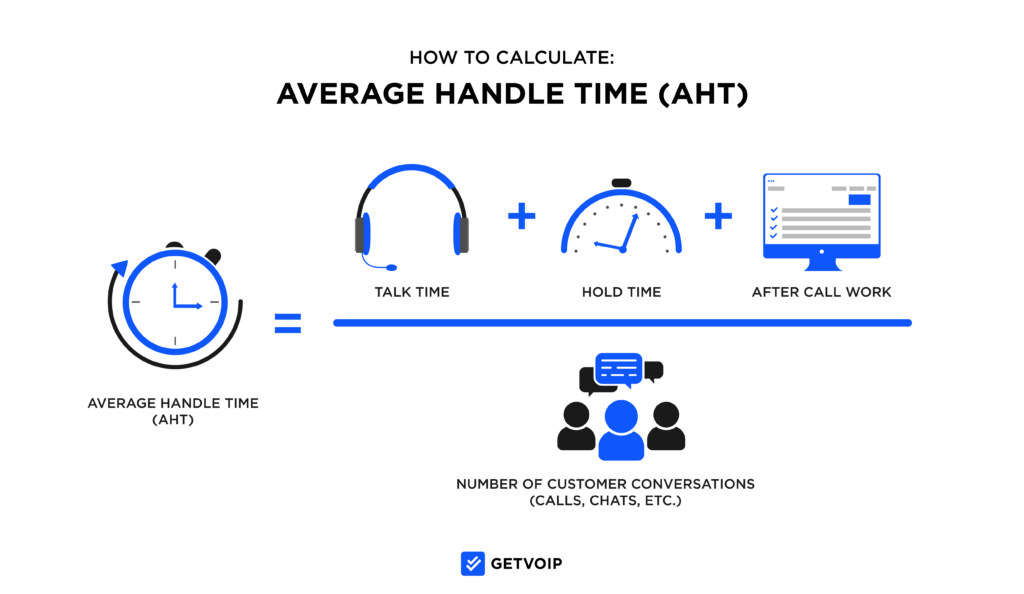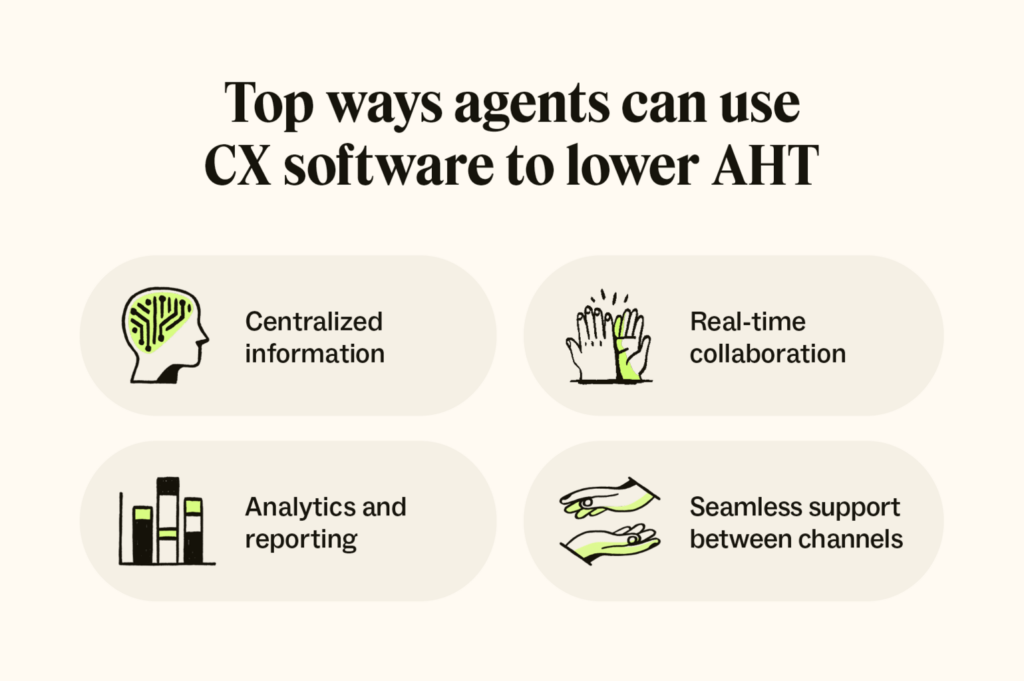Regularly reviewing call center analytics reveals trends in customer and agent behavior as well as insights into the efficiency of current operations.
AHT is an important metric that call center managers use to measure agent performance and customer service quality.
This article will explain what AHT is, how to calculate it, what a good AHT target is, why AHT matters, and tips to reduce AHT.

What Is Average Handle Time (AHT)?
Average Handle Time (AHT) refers to the average time an agent takes to handle a customer contact from the time they initiate the interaction to when they wrap it up.
For voice calls, it measures the typical duration from when the agent receives the call to completing after-call work after hanging up.
Specifically, AHT includes:
- Ring time – The time the call rings at the agent’s desk before they pick it up
- Talk time – The time spent conversing with the customer
- Hold time – Any time the customer is kept on hold during the call
- Wrap-up time – The time taken by the agent after the call to update records, enter notes, assign follow-up tasks, etc.
- Transfers – Any time spent transferring the customer to other agents or departments
For non-voice channels like email and live chats, AHT measures the time from when the agent accepts the contact to when they finish any administrative tasks associated with it.
AHT indicates the average time needed by agents to handle customer queries effectively. It is used to monitor individual and team performance.
How To Calculate Average Handle Time
The steps to calculate Average Handle Time are:
Step 1. Calculate total handle time:
Add up the handle times for all interactions handled by an agent or a group of agents over a defined period. This could be the total handle time per day, per week, per month, etc.
Step 2. Count the number of interactions
Count the total number of customer interactions (calls/chats/emails) handled during that period.
Step 3. Divide total handle time by number of interactions:
AHT = Total Handle Time / Total Interactions
Let’s look at a simple example:
- Over one hour Tom handled 10 calls with a total handle time of 60 minutes
- Mary handled 8 calls with a total handle time of 40 minutes
Tom’s AHT = 60 minutes / 10 calls = 6 minutes
Mary’s AHT = 40 minutes / 8 calls = 5 minutes
AHT can be calculated for individual agents, teams, or entire call centers. Identifying agents with the lowest and highest AHT helps assess training needs.
What Is a Good Average Handle Time?
A good average handle time depends on many factors:
- Industry- Technical support calls need longer than simple retail order status calls.
- Call types – Billing questions typically take less time than in-depth customer service issues.
- Products/Services – Complex offerings require more explanation and troubleshooting.
- Customer expectations – Customers expect a fast resolution for simple inquiries.
- Company standards – Each organization defines AHT goals based on business needs.
As a general guideline:
- 2-3 minutes – Reasonable for simple, routine calls like checking account balances or address changes.
- 3-5 minutes – Acceptable for moderately complex issues like billing questions or password resets.
- 5-7 minutes – Typical for troubleshooting technical issues or handling detailed orders.
- Above 10 minutes – This may be justified for very complicated customer issues or intensive sales calls.
Of course, shorter AHT is desirable as long as it does not negatively impact call quality. Customers should not feel rushed.
Finding the optimal AHT improves operations and customer satisfaction.
Why Is Average Handle Time Important?
Average Handle Time is a crucial metric because it impacts many aspects of contact center operations including:
- Agent productivity – Lower AHT translates to more calls handled per agent per hour, reducing payroll costs.
- Service levels – Shorter calls ensure callers don’t wait too long in queues, improving customer experience.
- Customer satisfaction – Quick call resolution decreases customer effort and increases happiness.
- First call resolution – AHT sets targets for resolving queries in one call rather than transfers or callbacks.
- Revenue generation – Lower AHT allows agents to generate more sales through increased call volume.
- Staffing needs – AHT helps determine optimal staffing to handle projected call volumes.
- Coaching needs – AHT shows agents need help to improve efficiency.
- Capacity planning – Historical AHT helps forecast calling loads and staffing budgets.
- Cost savings – Reduced handling time lowers labor expenses.
Monitoring AHT is thus essential for contact centers to control costs while maintaining service quality.
How to Reduce Average Handle Time?
Here are some proven strategies managers can employ to lower AHT:
1. Provide Comprehensive Training
Proper new hire onboarding and ongoing training in products, services, tools, and call-handling processes allow agents to become skilled at their job.
Well-trained agents can resolve queries faster and more accurately.
2. Enable First Contact Resolution
Empower agents to resolve customer issues in one interaction rather than blind transfers or callbacks. This avoids wasted time explaining the issue repeatedly.
3. Standardize Processes
Define and document standard protocols for answering common questions and handling routine tasks. Standard procedures enable consistent and fast responses.
4. Implement Knowledge Management
Equip agents with knowledge bases, FAQ lists, and technical resources so they can access information quickly without having to ask supervisors.
5. Use Call Guides
Provide agents with call flow templates, troubleshooting guides, and question prompts so they can handle calls systematically.
6. Automate Tasks
Identify repetitive tasks that can be automated through IVRs, chatbots, and other tools to offload them from agents.
7. Allow Screen Pops
Have relevant applications and information pages automatically “pop” on the agent’s screen based on incoming call data to eliminate lookup time.
8. Monitor Calls Live
Listen to calls in real time and provide instant feedback to help agents improve call efficiency and AHT.
With rigorous training regimens and optimizing processes, technology, and resource planning, call centers can reduce AHT by 15-25% or more.
How Call Center Software Enables Lower AHT?
Sophisticated call center systems provide powerful capabilities to enhance agent productivity and lower handling times:
- CRM integration – Gives agents quick access to customer profiles and history to avoid lengthy lookups.
- Knowledge management – Centralized knowledge bases and tech resources help agents resolve issues faster.
- Smart scripting – Guides agents with dynamic call flow templates tailored to customer responses.
- Process automation – Built-in workflows for updating data, assigning tasks, etc. speed up after-call work.
- IVR self-service – Automated options via interactive voice response steer simple requests away from agents.
- Screen pop-ups – Automatically display relevant applications or pages based on incoming calls for faster context switching.
- Real-time alerts – The dashboard highlights long calls so supervisors can proactively assist agents.
- Speech analytics – Analyze call recordings to identify root causes of excessive handle times.
- Reporting – Historical and real-time reports provide data-driven insights to improve AHT.
Investing in an advanced cloud contact center platform with the latest innovations can significantly optimize AHT while enhancing customer interactions.

Frequently Asked Questions (FAQ)
Ques 1. What is a good average handle time for customer service?
Ans. For moderately complex customer service calls, a good AHT target is 3-5 minutes. Simpler inquiries may take 2-3 minutes, while highly complex issues could take 5-7 minutes or longer.
Ques 2. How much should the average handle time be to provide good customer service?
Ans. Average handle time should allow agents to have a natural conversation with customers and resolve their issues completely in one interaction. For most routine customer service calls, an AHT between 2 and 5 minutes is recommended.
Ques 3. Is a shorter average handle time always better?
Ans. Not necessarily. A shorter AHT is better only if it does not negatively affect quality interactions. Calls should not be rushed or cut abruptly short just to lower AHT. Customers should feel listened to. The focus should be friendly, efficient service.
Ques 4. How can we encourage agents to reduce average handle time?
Ans. Coaching, call monitoring, standardized processes, knowledge management tools, performance incentives, and positive reinforcement can motivate agents to increase productivity and meet AHT targets.
Ques 5. What technology helps agents reduce average handle time the most?
Ans. Tools like knowledge bases, screen pops, CRM integration, and smart scripting have the biggest impact in reducing research and after-call work time for agents leading to lowered AHT.






